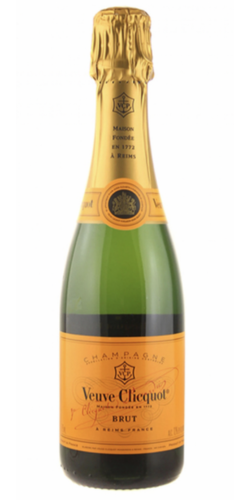
Our Rating

Champagne
Champagne
It’s also one of the most historically significant and innovative Champagne houses, thanks to the forward-thinking widow-come-founder, Madame Clicquot. We recently revisited the brand’s iconic Yellow Label sparkler.
The creator of Veuve Clicquot is often credited as Philippe Clicquot, a textile merchant who also ran a side business selling wine. Philippe began selling wine in 1772, and it’s important to note that this wasn’t sparkling wine. It was still wine.
According to this brief history of champagne, “…by the end of the 18th century, non-sparkling pinkish wine production [in Champagne] still accounted for over 90% of the Champagne region’s production.”
Sparkling wine would not become Champagne’s dominant style of wine until the mid-19th Century.
While Philippe is cited as the creator of what is now one of the most recognizable Champagne brands in the world, it was his daughter-in-law, Barbe-Nicole, who is credited with making Veuve Clicquot into the powerhouse that it is today.
Barbe-Nicole’s husband, Francois Clicquot, was given his father Philippe’s wine business to run, but the two had different visions for the business. Philippe saw no future for the wines of Champagne, but Francois and Barbe-Nicole disagreed. Wine intrigued Francois, and he believed that this side business could be expanded into its own operation and that there was more profit to be made. Against his father’s wishes, he and Barbe-Nicole set out to learn more about winemaking.
Getting the business off the ground proved challenging. The Clicquot’s situation took a tragic turn just six years after their marriage when Francois suddenly became sick and died just 12 days later.
It took some convincing for Philippe to allow his daughter-in-law to take over the business, not because she was a woman in an age when men dominated the industry, but because Philippe just didn’t see a path to profitability for Champagne.
The Champagne business ultimately sputtered, and Barbe-Nicole had to approach her father-in-law, not once, but twice for a loan to keep it afloat. It wasn’t until a political change occurred in 1811 that her fortunes changed.
If the Russians had not had their supply of champagne cut off by the Napoleonic wars and had the demand that followed the end of the war not been so great, it’s unclear whether the house of Veuve Clicquot would have survived.
In the early part of the 19th Century, the Russian market loved sweet Champagne, and that was exactly the style that Madame Clicquot was turning out – the Champagne was twice as sweet as what we now call ‘Demi-Sec’ today. She knew that if she could get her bottles to Russia, she could save her business and prove its worth to her father-in-law. The only problem was that naval blockades were still preventing goods from being shipped to Russia until the Napoleonic wars were declared officially over.
In a cunning move, Clicquot smuggled her Champagne out of France and stationed it in Amsterdam, thus staying one step ahead of her competitors, who were also eyeing the market. This way, when the blockades were removed, she would be the first to market in this Champagne-thirsty region.
The move worked, and the bottles sold out instantly. As did the next shipment, which was spoken for before the boat even docked at port!
Madame Clicquot’s shrewd business decision ultimately saved the Clicquot label and set it on a course to become one the most successful Champagne houses in the world.
Veuve is actually French for ‘widow’ so the name Veuve Clicquot means Widow Clicquot. The sometimes used ‘Veuve Clicquot Ponsardin’ includes Barbe-Nicole’s maiden name.
The influence of Madame Clicquot cannot be understated. Here are just a few of the incredible ways she influenced Champagne making:
Veuve Clicquot Brut Yellow Label is non-vintage Champagne made by blending various vintages to achieve a signature taste that sparkling wines lovers have come to love. Veuve uses as many as 60 different crus when making Yellow Label, with Pinot Noir the dominant blending grape at approximately 50-55%. Chardonnay is used at roughly 28-33%, and the remaining wine is made up by Meunier.
The nose on a glass of Veuve Clicquot is aromatic and fresh. That quintessential Champagne “breadiness” or toast quality is the first aroma to greet you. Notes of pear, peach, and apple follow.
A flurry of small bubbles fills the palate, which is dry rather than sweet. The taste is crisp with streaks of lemon and chalky minerality.
A fantastic bottle of Champagne, although not a five on our value rating, this is still worth a try.
France
Champagne
Champagne
12
Didier Mariotti
N/A
Now to 2030
Manoir De Verzy


All things wine, and food you could ever need or want — straight to your email!